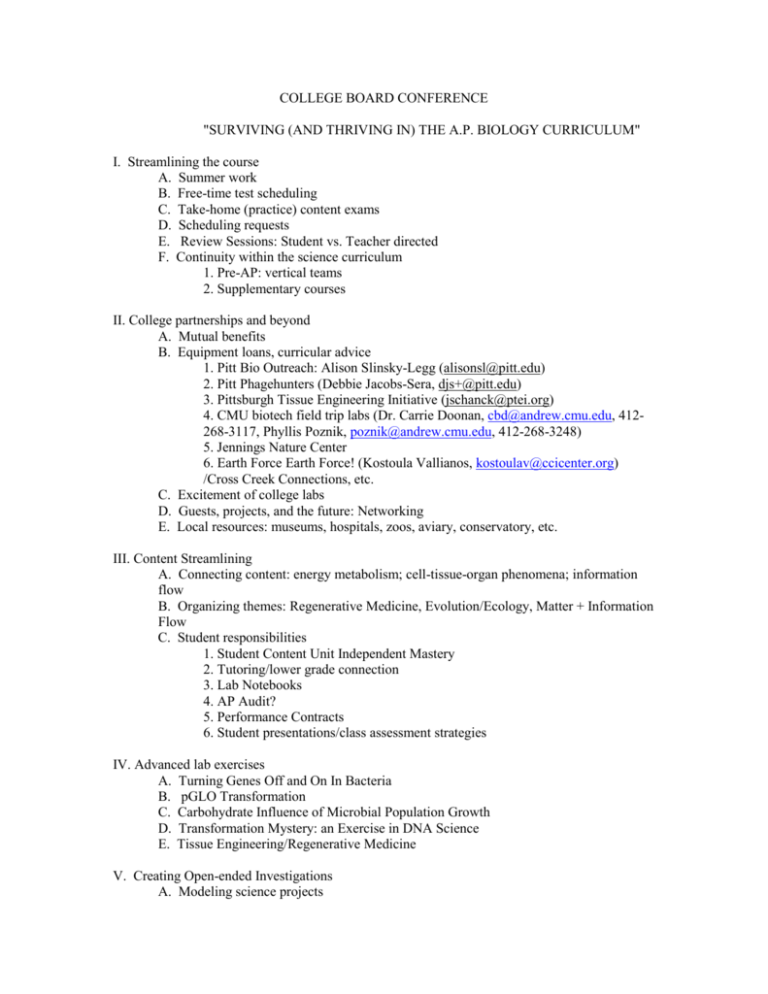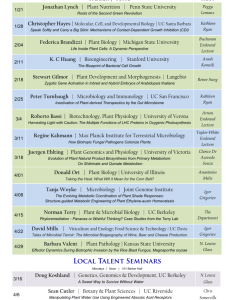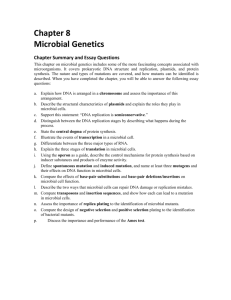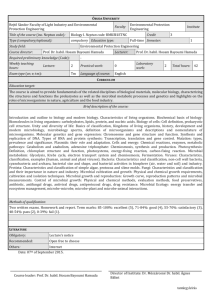AP Bio presentation outlines 2007
advertisement

COLLEGE BOARD CONFERENCE "SURVIVING (AND THRIVING IN) THE A.P. BIOLOGY CURRICULUM" I. Streamlining the course A. Summer work B. Free-time test scheduling C. Take-home (practice) content exams D. Scheduling requests E. Review Sessions: Student vs. Teacher directed F. Continuity within the science curriculum 1. Pre-AP: vertical teams 2. Supplementary courses II. College partnerships and beyond A. Mutual benefits B. Equipment loans, curricular advice 1. Pitt Bio Outreach: Alison Slinsky-Legg (alisonsl@pitt.edu) 2. Pitt Phagehunters (Debbie Jacobs-Sera, djs+@pitt.edu) 3. Pittsburgh Tissue Engineering Initiative (jschanck@ptei.org) 4. CMU biotech field trip labs (Dr. Carrie Doonan, cbd@andrew.cmu.edu, 412268-3117, Phyllis Poznik, poznik@andrew.cmu.edu, 412-268-3248) 5. Jennings Nature Center 6. Earth Force Earth Force! (Kostoula Vallianos, kostoulav@ccicenter.org) /Cross Creek Connections, etc. C. Excitement of college labs D. Guests, projects, and the future: Networking E. Local resources: museums, hospitals, zoos, aviary, conservatory, etc. III. Content Streamlining A. Connecting content: energy metabolism; cell-tissue-organ phenomena; information flow B. Organizing themes: Regenerative Medicine, Evolution/Ecology, Matter + Information Flow C. Student responsibilities 1. Student Content Unit Independent Mastery 2. Tutoring/lower grade connection 3. Lab Notebooks 4. AP Audit? 5. Performance Contracts 6. Student presentations/class assessment strategies IV. Advanced lab exercises A. Turning Genes Off and On In Bacteria B. pGLO Transformation C. Carbohydrate Influence of Microbial Population Growth D. Transformation Mystery: an Exercise in DNA Science E. Tissue Engineering/Regenerative Medicine V. Creating Open-ended Investigations A. Modeling science projects B. Modifying your standard labs C. Supplementary Labs 1. Pseudoscience as an exploratory exercise 2. Bubbleology and respiratory capacities 3. Neuroscience 4. Pollution Assessment 5. Growth and Survivorship exercises 6. Tissue Engineering 7. Star Trek Dissection Survey VI. Molecular Simulations, "Beyond Bead Biology" VII. A.P. Exam review A. Practice tests, essays, and review sessions B. Student participation: Biology Trivial Pursuit, Bio Jeopardy and Review Game C. Tutoring and mastery D. Building Practice into Curricular Tests/assignments "UNLEASHING THE STUDENT SCIENTIST" "STRESSING SCIENCE IN BIOLOGY" I. Selling science and the power of critical thinking A. Stating the problem: misinformation and pseudoscience B. Second hand sources and reliability 1. “The good, the Bad, and the Ugly”: student second hand source evaluation 2. Building a baloney detection kit C. The skeptic as scientist 1. James Randi: Flim Flam and Secrets of the Psychics 2. Carl Sagan: The Demon Haunted World and the Fine Art of Baloney Detection 3. The power and application of statistics 4. Exploring Psychic Powers: Randi Investigation + Beyond Science? (SAF) 5. X-Files: psychic phenomena investigation 6. “Wood a Termite Follow Directions?” Science Process Intro/Discovery D. The student as scientist: Bubbleology or Paper Towel Efficiency Labs E. Strength and Limits of science: "beyond a reasonable doubt" II. Emphasizing science in the biology curriculum A. Ecology/Environmental Science: 1. Microbial/Algae Growth Influence 2. Human Survivorship 3. Winogradsky Columns 4. Water Detectives: Chemical and Biological Analysis (Earth Force?) 5. Paper towel Efficiency 6. Second Hand Smoke effects on microbes 7. Coliscan plate water analysis 8. Pollution Assessment 9. Fantastic Farmers! (Competition) 10. Biome Brochure and Biome Bingo 11. Energy Efficiency Design Competition 12. Pesticide Effects on Microbial Survivorship 13. “Wood a Termite Follow Directions?” Law of Unintended Consequences! B. Cell: Chemical detectives 1. Biochemical Assay: rainbow spectrophotometry 2. Protein electrophoresis + column chromatography 3. The cell challenge 4. Design a cell investigation 5. Biochemical food analysis 6. Metric mastery challenge 7. Building a cell: artificial life (Science Now) C. Enzymology: 1. Environmental influences on activity 2. Primetime enzyme simulation 3. Salivary amylase lab 4. Catalase (AP Bio Lab) D. Transcription/Translation: 1. Turning genes off and on in bacteria 2. D.N.A. - Distant Nucleotide Apogee 3. Microbial mutagenesis 4. James Bond Cellular Spy Activity E. Energetics/Photosynthesis/Respiration: 1. Wavelength or chemical influence on PS 2. Carbohydrate influence on microbial growth/ respiration F. Genetics: 1. Personal pedigrees (a family project) 2. Planet Reebop G. DNA science: 1. Transformation efficiency 2. Transformation mystery 3. PCR or RFLP simulation mystery 4. DNA sequencing with beads 5. D.N.A. - distant nucleotide apogee 6. DNA research team challenge 7. Cracking the Code of Life (Nova), Mouse that Laid the Golden Egg (Secret of Life series), RNAi (Science Now), Human Genome Project (DNA series), Journey of Man (Nova special: evolution overlap), Harvest of Fear (Frontline: GMO’s) H. Evolution: 1. Natural selection of "Skittlicius delicious" 2. Molecular data reconstruction 3. Stabbers, wrestlers and rammers, morphology of horns and fighting behavior in Bovidae 4. Sol III: an evolutionary perspective (Museum Madness) I. Microbial models for inquiry 1. Bacteria 2. Yeast 3. Microbial survival inquiry 4. Environmental influence on phage infectivity J. Protista: 1. The protist race 2. Stentor taxis K. Plants: 1. The plant game 2. Fast plants made simple 3. Transpiration and/or germination influence 4. Fantastic Farmers! (Competition) 5. Environmental/Evolution Influence on Plant Form and Function (Len Lehman: Retired Botany/AP instructor) L. Animalia: 1. Planaria behavior 2. Star Trek dissection discovery! 3. Sow bugs, brine shrimp, termites, etc. taxis/habitat selection 4. Animal embryology/development M. Human Physiology 1. Heart rate influence 2. Human respiratory capacities 3. Homunculus Man/sensory mapping 4. Neural response time 5. Muscle madness! 6. Human center of gravity 7. Meat Adulteration: Immuno techniques (Carolina) 8. Tissue Engineering curricular supplement! N. STUDENT INDEPENDENT PROJECTS A number of these activities can be sent via email. Just send me an email and I will send a large file of lessons. To obtain hard copies of any of these and/or more valuable life science activities, contact Mark Krotec: 102 Hodil Terrace, Pittsburgh PA 15238 (H) 412-963-1273 © 412-916-2439. mckrotec@yahoo. com. I will be glad to answer any questions and offer tips on classroom utilization. Also, if you wish to schedule a workshop, please call or email. NOTE: Some of these activities are not yet in written form. These can be described through email or phone. Thank you.






